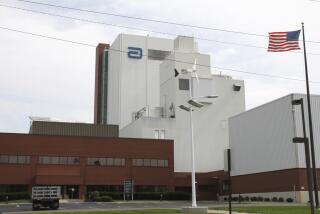Vaccine-maker tries to assure patients H1N1 doses are safe
- Share via
Reporting from Allentown, Pa. — Forget the chicken. At vaccine-maker Sanofi Pasteur, it all starts with the egg -- millions of them each week. The mini vaccine factories will grow more than 75 million doses of H1N1 vaccine this year.
Earlier this month, the only company to make flu shots in the United States offered reporters a glimpse of select parts of the production process at its 540-acre campus in Swiftwater, Pa. There, Sanofi produces vaccines for the flu as well as polio, meningitis, cholera and other bacterial and viral diseases.
By opening their doors, company executives hoped to assure people that the H1N1 vaccine is safe, made the same way seasonal flu shots have been made for decades.
“We see a lot of media reports and people wondering about whether to take it,” said Ryan Riboldi, senior director of quality assurance. “We just want people to see that we’re proud of what we do and what goes into making it.”
Production begins, unofficially, at special farms across the country devoted to producing eggs that will grow the viruses used to make vaccines. The farms are kept completely sterile, said Sanofi scientist Samson Lee, who is responsible for the production of the H1N1 vaccine. “It’s a highly controlled process,” he said.
The hens are allowed to roam freely, and the fertilized eggs are trucked to Sanofi soon after they are laid.
Eggs are a perfect petri dish for influenza. When they arrive at Sanofi, the eggs are placed in trays on a conveyor belt. An automated machine, equipped with rows of needles, delivers a quick punch to the eggs, injecting them with the live virus.
The clear membrane in the egg closes, sealing what is now essentially a sterile factory that’s kept at a controlled temperature for several days and allowed to grow the virus.
For the seasonal flu vaccine, scientists around the world identify which strains are most dominant. The World Health Organization and the U.S. Food and Drug Administration then select three strains.
The mix often changes from year to year. Sanofi is accustomed to dealing with new strains, which is why H1N1 posed no unique challenges. “It’s the same process,” Lee said. “It’s just a different strain.”
Sanofi’s chief executive, Wayne Pisano, acknowledged that processing of the H1N1 vaccine was accelerated, cutting a six-month time frame to four months. Pisano said that was accomplished by employees working long hours, canceling honeymoons and, in the case of one employee, returning to work the day his first child was born.
The manufacturing plant is operating around the clock to fulfill its obligation to deliver 75 million doses by the year’s end. The company’s $190-million government contract was announced in May.
The H1N1 virus was initially slow-growing, which delayed its distribution. Sanofi, which produces more than 45% of the influenza vaccines distributed in the United States, expects to produce 125 million doses of both seasonal and H1N1 vaccine by the end of the year.
For the seasonal flu vaccine, each of the three virus strains is grown in its own egg. When ready, the virus-loaded fluids in each egg are extracted and combined to make one vaccine. The process is the same for H1N1, except only one virus strain is needed.
After the fluid is extracted from the eggs, it is purified in giant steel tanks, and a special chemical is added to kill the virus.
Testing and quality control is next, a process that takes about 85% of the time required to make the vaccine.
In the quality-control lab, technicians in blue bubble suits work inside air-sealed plastic enclosures performing several tests on vaccine samples. The samples are passed through sealed portals so they are never exposed to air or touched by human hands.
“It’s modeled after the docking operations in space,” said Susan Powers, the company’s vice president of quality operations.
Powers said all batches of the H1N1 vaccine have so far tested free of contaminants.
Sanofi then fills and packages the vaccine in syringes and vials. At the packaging building, syringes are lined up on processing machines. As they zip by on a conveyor belt, a computer scans for defects.
The rejection rate, Riboldi said, is less than 1%.






